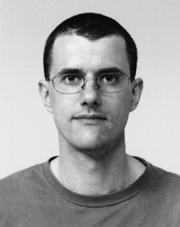
| Jens Gerlach Parallel and Distributed System Performance TRC Laboratory |

| Jens Gerlach Parallel and Distributed System Performance TRC Laboratory |
Profile Affiliation: Parallel and Distributed System Performance TRC Laboratory, RWCP Tsukuba Research Center Date of birth: August 8, 1965 Birthplace: Jena, Germany Background: 1986~1991 Study of Mathematics at Humboldt University, Berlin 1992~1996 GMD Berlin (German National Research Center for Information Science) 1996~ Tsukuba Research Center of RWCP
After two short visits of the Tsukuba Research Center in March 1994 and January 1996 I joined the Parallel and Distributed Software Laboratory in May 1996.
Before I was working in the PROMOTER Project of the GMD that was sponsored by RWCP. GMD has sent me to Tsukuba to deepen its research relations to the central laboratory of the Real World Computing Partnership.
In PROMOTER (now succeeded by the PROMISE Project) we developed a high level programming model for data parallel applications. My particular subject was application analysis that is, trying to identify what are the essential spatial and communication patterns of high performance applications.
Knowing these structures we designed a programming model that fits the needs of high performance applications. For more informations on the goals and results of the PROMOTER project look at the http://www.first.gmd.de/org/promot.html web page.
In particular I dealt with finite difference methods for Computational Fluid Dynamics, particle simulations and Finite Element Methods (FEM).
FEM have taken our particular interest, since the complexity of the spatial structures (meshes resulting from irregular triangulations) makes their implementation usually very difficult on parallel computers with distributed memory.
At the Tsukuba Research Center I am working in the Distributed and Parallel Performance Laboratory, investigating performance issues of the implementations of parallel finite element methods and other numerical problems. In particular I am working on how modern software engineering concepts (like object-orientation) can be efficiently used in the field of high performance computing.
At first I ported a particle simulation method from the realm of material science to the workstation cluster of TRC.
The particle simulation methods is entirely written in the C++ programming language. To deal with the irregularity and inherent dynamics of that application we used the Standard Template Library (STL) of C++. An important insight was that this fairly general library can be applied for numerical applications without fearing dramatic losses in performance. For the parallel implementation I compared a standard implementation of the MPI message passing system with one that was realized with the MPC++ programming language developed at TRC.
Currently, I am developing a new description method for finite element methods. The spatial structures of finite element meshes shall be made explicit so that they can be evaluated by the compilation and run time systems of parallel programming models.
This seems to be the only way to permit an automatic locality preserving mapping of the meshes onto the parallel architecture and to directly generate a message passing implementation.
For this the description scheme must be oriented towards the application domain and abstract from particular low level implementation techniques that would be harmful on certain computer architectures.
It is one of the misconceptions we often meet in programming that abstraction equals to low performance.
The contrary is true, since only an abstract application-oriented description gives the implementor the flexibility and freedom to create high performance implementations.
Of course, working at the Tsukuba Research Center is not only research in parallel computing. For me it means: experiencing Japan --its people, language, and culture--and I can say that I really appreciate having this experience.